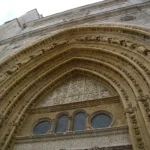Barcelona is a city where art, architecture, and history entwine in streets and squares. Among its treasures, the Sagrada Familia stands towering, a colossal basilica celebrated worldwide for its breathtaking design and intricate craftsmanship. This monumental creation, rooted deeply in Catalan Modernisme and organic architecture, reflects the genius of Antoni Gaudí and embodies over a century of evolving styles and visions. Situated in the heart of Barcelona, Spain, this basilica captivates visitors by its soaring spires, detailed facades, and symbolic imagery, making it a must-see landmark for those drawn to architectural marvels and cultural heritage.
Table of Contents
Whether approaching from Barcelona’s bustling city center or arriving from El Prat Airport or the main railway stations, the journey to Sagrada Familia is an accessible exploration of urban life and history combined. Nearby accommodations range from charming boutique hotels to comfortable guesthouses, all offering a lively neighborhood atmosphere. After your visit, treat yourself to traditional Catalan dishes at local restaurants, where the flavors of seafood, cured meats, and fresh vegetables pay homage to the Mediterranean coast.
For those inspired by the Sagrada Familia’s beauty, Barcelona’s cultural and food spots offer a perfect next stop to feel the city’s vibrant life.
Navigating to Barcelona’s Iconic Basilica with Ease
Reaching the Sagrada Familia is straightforward thanks to Barcelona’s comprehensive public transport network. From the city center, the metro is the most efficient mode:
- Take Metro Line 2 (Purple Line) or Line 5 (Blue Line) directly to the Sagrada Familia station; this places you right at the basilica’s doorstep.
- Several bus lines intersect near the site, including lines 19, 33, and H10, providing scenic views en route.
- From El Prat Airport, the Aerobus A2 runs to Plaça de Catalunya, where you can transfer to the metro lines mentioned above.
- If arriving by train, Barcelona Sants station connects seamlessly to the metro network, facilitating a quick transfer.
Walking from Plaça de Catalunya to the basilica also offers a fascinating urban stroll through Eixample’s grid, revealing modernist buildings and vibrant street life.
Architectural Language of Stone and Light
Sagrada Familia is not merely a building; it is a sculptural narrative carved in stone, where every element speaks volumes. Gaudí’s vision redefined the traditional Gothic cathedral, replacing rigid lines with fluid, natural forms inspired by the geometry of nature. Columns inside the basilica resemble tree trunks branching out to support the ceiling, creating a forest of stone that directs the eye upwards toward stained glass windows that flood the space with ethereal light.
After admiring Barcelona’s architectural gems, visiting St. Stephen’s Cathedral in Vienna offers a stunning look at Gothic design and centuries of history.
The basilica’s façades – the Nativity, Passion, and Glory – each tell distinct stories from the life of Christ, rendered with an intense emotional depth. The Nativity facade, completed during Gaudí’s lifetime, exhibits intricate detail and exuberant ornamentation, celebrating life and creation. Conversely, the Passion facade presents a stark, angular contrast, evoking suffering and sacrifice.
This architectural evolution, spanning from the late 19th century into the present day, reflects transitions in design movements and advances in construction technology, all while preserving the integrity of Gaudí’s original plan. The basilica remains unfinished, symbolizing an ongoing dialogue between past and future generations of architects, artisans, and engineers.
For a contrasting Gaudí masterpiece surrounded by nature and mosaics, you can visit Park Güell in Barcelona’s Gràcia district.
Planning Your Visit: When to Go and How to Book
Best Moments for Quiet Contemplation
Visiting the Sagrada Familia during weekdays, especially early in the morning or late afternoon, often means fewer crowds and a more intimate experience. The light at these times enhances the stained glass windows, casting vibrant colors across the interior. Avoiding weekends and public holidays is wise, as the site attracts large numbers of tourists.
Reservations and Tour Details
Due to its immense popularity, advance reservations are essential. Tickets can be purchased online through the official website of the Sagrada Familia, which offers various options including standard entry, guided tours, and access to the towers. Guided tours provide enriched understanding of the basilica’s symbolism, construction history, and Gaudí’s philosophy. Audio guides are also available for those who prefer a self-paced exploration.
The ongoing construction work means some parts of the basilica or towers may occasionally be closed for safety or restoration; checking current visitor information before arrival ensures a smooth visit.
Surrounding Life: Stay, Eat, and Feel the Neighborhood
The area around Sagrada Familia buzzes with local life, offering visitors a chance to immerse themselves beyond the basilica. Accommodations in this quarter cater to diverse preferences, from quiet, family-run guesthouses to modern apartments with sweeping city views.
When hunger strikes, sampling dishes such as escudella i carn d’olla (Catalan stew) or pa amb tomàquet (bread rubbed with tomato) at local eateries provides authentic tastes of Barcelona’s cuisine. Nearby, markets and bakeries invite exploration with fresh produce and traditional sweets like panellets.
Little-Known Facts and Stories Behind the Stone
One of the lesser-known aspects of the Sagrada Familia involves its symbolic integration of natural geometry. Gaudí studied botany and geology meticulously, applying mathematical structures such as hyperboloids and paraboloids to create forms both structurally sound and visually captivating. The basilica’s spires are not purely ornamental; they serve as vertical poems, dedicated to apostles, evangelists, the Virgin Mary, and Jesus Christ.
An intriguing anecdote recounts how Gaudí would enter the construction site barefoot, believing it brought him closer to God and his work. His devotion extended beyond design, influencing the very spirit of the basilica as a living, breathing entity still unfolding.
Official Information and Online Resources
For the latest updates on visiting hours, ticket prices, and construction progress, consult the official Sagrada Familia website. It provides reliable information and the safest way to secure your entry:

